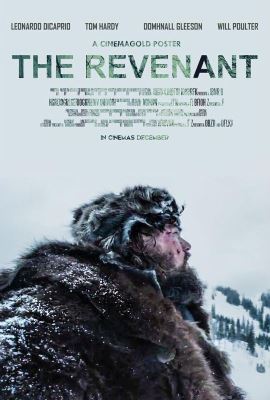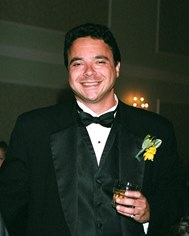 At its core, “The Revenant” is a throwback to those gritty revenge-fueled westerns that I’ve always loved: the protagonist sifting through the savage elements of the wilderness to exact frontier justice. Along the way, harsh weather, scarce food resources, and wild animals seem like child’s play against the real danger lurking out in the wild- man himself.
At its core, “The Revenant” is a throwback to those gritty revenge-fueled westerns that I’ve always loved: the protagonist sifting through the savage elements of the wilderness to exact frontier justice. Along the way, harsh weather, scarce food resources, and wild animals seem like child’s play against the real danger lurking out in the wild- man himself.
Leonardo DiCaprio stars as Hugh Glass, a guide to a group of fur-trappers collecting pelts for profit. After an invading horde of Pawnee Indians attack the group with an arsenal of arrows, the remaining small band of trappers flee by boat but are advised by Glass to abandon the water and retreat to their base by land to throw off the Pawnee. Glass knows the tracking ability and ways of Indians well, as evidenced by his half-breed son Hawk (Forrest Goodluck) who stays at his father’s side. This doesn’t sit well with one of the trappers, Fitzgerald (Tom Hardy) – not only doesn’t he agree with Glass’ plan, he has a true hatred for Indians after surviving an attempted scalping. Just seeing Hawk reminds Fitzgerald that Glass is not to be trusted.
Unfortunately for Glass, he is mauled by a bear during a brief separation from the group. The group’s captain (Domhnall Gleeson) orders Glass’ battered and broken body to be carried on a makeshift stretcher while Glass clings to life. Glass’ chance for survival is remote; his incapacitation impedes the group’s hasty retreat from the advancing Pawnee. When the group can no longer continue with Glass in tow (and as the captain cannot put Glass out of his misery despite Fitzgerald’s pleading they do so), two trappers are ordered to remain with Glass while the others continue toward base camp. When the captain states he will handsomely pay those who remain with Glass, Fitzgerald volunteers. As the order also includes a proper burial for Glass upon his death, it’s not long before we know Fitzgerald will start digging the hole.
What follows is a great scene between DiCaprio and Hardy, and the two actors really showcase their talents in “The Revenant.” Away from the prying eyes of Hawk and the other trapper who remain, Fitzgerald agrees to end Glass’ suffering if he blinks acceptance (Glass can barely talk). Fitzgerald moves close to Glass’ face, droning on about killing Glass if he just agrees- there’s a genuine suspense here because you know the blink’s coming, voluntary or not. When Glass does blink, Fitzgerald’s attempt at euthanasia is thwarted by Hawk, who cries out for the other trapper’s help but dies himself at Fitzgerald’s hand. Hiding Hawk’s body, Fitzgerald convinces the other trapper that Hawk’s crying out has alerted the advancing Pawnee and they should bury Glass and flee. After they leave, Glass crawls out of his impromptu grave to lay with his dead son- his will to survive transformed into an indomitable spirit bent on revenge.
Just in its story, “The Revenant” has elements of westerns I’ve loved. Whether it’s the journey of retribution after the murder of one’s wife and child and the subsequent meeting of Indian confidantes as seen in Clint Eastwood’s “The Outlaw Josey Wales” or the search for an abducted girl and the general hatred for Indians from John Ford’s “The Searchers” or even the solitary life of a mountain man being broken by Native Americans in Sydney Pollack’s “Jeremiah Johnson,” the movie I can most closely associate with the overall tone and look of “The Revenant” would be Joe Carnahan’s 2011 film “The Grey” with Liam Neeson. Just as Neeson trudges through the snow-covered Alaskan wilderness after a plane crash leaves his small group of oil workers stranded to survive among the predatory wolf pack pursuing them, his mind turns to the memory of his wife to sustain him. DiCaprio also has memories of his Indian wife to sustain him in “The Revenant” and both films have a color-washed cinematography that encapsulates the cold and dread that defines their environment.
Directed by Alejandro G. Inarritu, last year’s Oscar-winner for “Birdman,” “The Revenant” maintains Inarritu’s strength in connecting subplots and continues to use his continuous fluid one-take process to great effect. In addition, the best scenes in “The Revenant” also seem to channel Steven Spielberg: the opening onslaught by the Pawnee isn’t so far removed from the shock and surprise of the Normandy beach battle in “Saving Private Ryan” and the CGI effects in the bear mauling scene are on par with the dinosaur attacks in “Jurassic Park.”
Bolstered by DiCaprio and Hardy’s performances and with a formidable director in Inarritu, “The Revenant” maintains a nod to classic westerns in the form of a well-crafted psychological survival tale. Its protagonist is aptly named- even broken glass sparkles despite being shattered.
